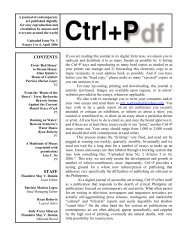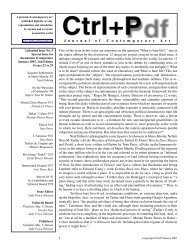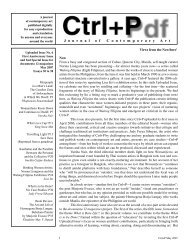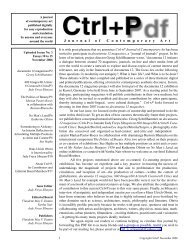Issue 15 - Pdf Ctrl+P - CTRL+P: a journal of contemporary art
Issue 15 - Pdf Ctrl+P - CTRL+P: a journal of contemporary art
Issue 15 - Pdf Ctrl+P - CTRL+P: a journal of contemporary art
You also want an ePaper? Increase the reach of your titles
YUMPU automatically turns print PDFs into web optimized ePapers that Google loves.
amidst such utopic conditions as full disclosure (who is collecting what and why should<br />
they be inhibiting themselves from specific venues for valuation—exhibit programming,<br />
judging, etc.) and a seamless information system that allows contending ideas to get to<br />
the people who need to hear and digest them most. Leung speaks <strong>of</strong> how <strong>art</strong> is ‘rudderless’<br />
p<strong>art</strong>icularly in the ideal world where the ultimate arbiters would be the makers <strong>of</strong> <strong>art</strong><br />
themselves who might in fact choose to be intractable. But hope floats or all <strong>art</strong>making<br />
would cease. Thus the only tenable way to keep the <strong>art</strong>world honest would be if all agents<br />
would enter into the fray, boldly if not inerrantly speak rather than succumb to merely<br />
working out <strong>of</strong> each other’s comfy and self-interested nests. There are no pat answers<br />
but at least attempting to journey toward them is genuine gain.<br />
irene s. leung<br />
What Does “Recovery” Look Like<br />
in the Art World? Or Surviving<br />
the Next Art Market Bubble<br />
News about General Motors re-emerging out <strong>of</strong> bankruptcy in just one month sent all<br />
the media pundits scrambling for words. With 27,000 fewer employees and 13 fewer<br />
car plants, it somehow acquired a new sheen—“smaller, leaner, tougher.” I for one, feel<br />
that we are all our own individual GM companies—we have become leaner and tougher<br />
through the hard times. But is there a comparable example in the <strong>art</strong> world?<br />
With the overnight vanishing <strong>of</strong> wealth and the near-collapse <strong>of</strong> the credit markets,<br />
some, like Holland Cotter, <strong>art</strong> critic <strong>of</strong> the New York Times, breathed a sigh <strong>of</strong> relief that<br />
<strong>art</strong>ists are once again left alone to make <strong>art</strong> rather than being picked over by “cadres<br />
<strong>of</strong> public relations specialists” (i.e. the critics, curators, editors, publishers and career<br />
theorists) driven by dealers, brokers, advisers, financiers, lawyers and…event planners. 1<br />
Granted, the <strong>art</strong> world has not and will probably never embrace speculative investment.<br />
But surely some <strong>of</strong> us would miss the frequent <strong>art</strong> fairs and biennales. Yet who is to say<br />
when the stock market eventually rebounds to irrational exuberance, that the critics,<br />
collectors, financiers, and dealers won’t contrive to create the next <strong>art</strong> market bubble?<br />
Which <strong>art</strong> works would become the darling <strong>of</strong> the market? Which country would be<br />
the hotbed <strong>of</strong> new talents? Who will be the new investors willing to inflate the next <strong>art</strong><br />
market bubble?<br />
Given that everyone seems to be waiting for a sign to see where the wind blows, the<br />
key question is not so much about how to do away with market agents because speculators<br />
and investors are here to stay, but how <strong>art</strong> world depends on its rich patrons and has<br />
worked hard to influence what they think and how they invest. We are not speaking <strong>of</strong><br />
having a Cosimo de’ Medici, but the <strong>art</strong> world has depended on the collectors, donors,<br />
and corporations to keep it alive. What has been missing is a robust debate about monetization<br />
– where does <strong>art</strong> practice intersect with money? Art needs an account balance<br />
sheet because <strong>art</strong> is livelihood. Art is also a subsidy because the <strong>art</strong> market only supports<br />
a small percentage <strong>of</strong> <strong>art</strong>ists very well while others do not receive much.<br />
The editors <strong>of</strong> this issue <strong>of</strong> <strong>Ctrl+P</strong> have rightly pointed out the interconnectedness<br />
<strong>of</strong> ‘<strong>art</strong> world’ and the ‘<strong>art</strong> market.’ One simply cannot exist without the other, yet the <strong>art</strong><br />
market and the <strong>art</strong> world play by very different rules and thrive on different stimulants. As<br />
<strong>art</strong>ists and <strong>art</strong>s pr<strong>of</strong>essionals, we seem to always be on the defensive, constantly justifying<br />
the role <strong>of</strong> <strong>art</strong>s in society. Why must the <strong>art</strong>s be seen as expendable as corporate jets<br />
in times <strong>of</strong> financial crises? Why are the utilities <strong>of</strong> <strong>art</strong>s constantly being questioned, as<br />
opposed to, say, Math and sciences? On the other hand, the mantra <strong>of</strong> “<strong>art</strong> for <strong>art</strong>s sake”<br />
actually undermines the extraordinarily diverse and complex reasons why we make <strong>art</strong><br />
and pay for the <strong>art</strong>s; it denies the social, religious and political functions that the <strong>art</strong>s<br />
serve in human history and continues to do so.<br />
<strong>Ctrl+P</strong> September 2009







